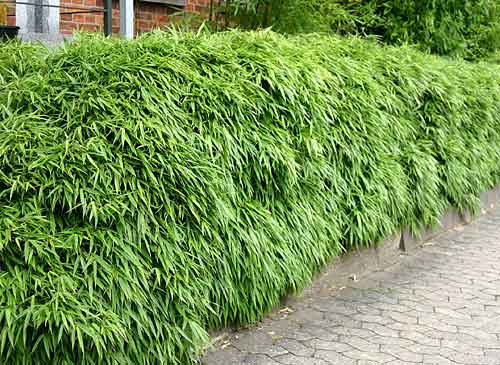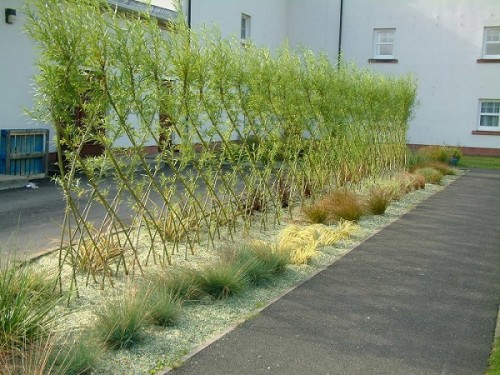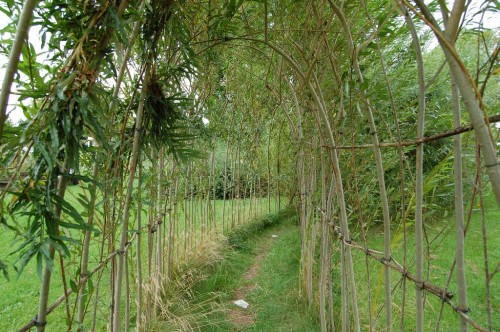Creating a recreation area on a personal plot, I want to protect it from prying eyes, without cluttering up with all this the territory with heavy structures. In this case, the hedges that can be done with your own hands will come in handy in this case.
Content
The most suitable plant for the construction of hedges of the plant
- barberry;
- sansshit;
- lavender;
- privet;
- currant;
- mulberry;
- yellow acacia;
- hornbeam;
- thuja;
- hawthorn;
- juniper;
- rose hip;
- willow et al.
Today we will pay attention to the process of landing and the formation of hedges from willow and all related features and nuances. A hedge of willow quickly grows, looks quite aesthetically (as can be seen in the photo) and does not require special care.
IVO - a genus of a plant, including several hundred species and a huge number of subspecies. It is characterized by rapid growth, and, therefore, there is a real opportunity to arrange a live fence in rather short rock.
The most affordable and demanded in landscape design varieties of willow
- Red Schelyuga.
- Krasnotal.
- White.
- Almighty willow.
- Ostrient verba.
- Tright -shaped willow.
- Purple willow.
- Red Verba.
- Three -thousandth willow.
- Five -thousandth willow.
Why willow?
- She is unpretentious.
- It grows very fast.
- Resistant to severe frosts.
- Calms the process of haircuts.
- Moisture loving (will not suffer from oversaturation of soil excess) moisture.
- It can be propagated by cuttings. Those. There is no need to purchase a large number of seedlings.
- All her subspecies are excellent honey plants (this is the attention of the owners of mini-passes in suburban lands).
Landing and formation of hedges from willow with your own hands
Formed hedge
Such a living fence requires additional attention to the formation of a certain pattern from the stems. The pattern of the ornament depends on your imagination. We will describe a fairly standard type of formed fence from willow.
What should you stock up on?
- pegs (their size is completely dictated by the length of the seedlings);
- cord for marking;
- shovel;
- twine for binding shoots;
- knife for cutting the bark;
- mineral fertilizers;
- water for watering;
- seedlings.
Annual plants need to be prepared from autumn, preserving them in the basement. Cuttings must be prepared by cutting even before the growing season. Cuttled later cuttings take root worse.
If you did not harvest seedlings yourself, then you can buy them. When acquiring an willow, pay attention to the fact that the roots are in a burlap or container. The soil inside the package should be wet. If the roots are dry, seedlings can be thrown away.
What and how to do?
- Put the pointed pegs along the line of the planned live fence, withstanding a step 1.5-2 m.
- Mark the marking by fixing the cord on the pegs.
- Dig the soil along the markings, raising a layer of earth about 50 cm.
- Make a slang soil with mineral fertilizers.
- Pour the drunk strip.
- Plant seedlings with an interval of 15-20 cm and at an angle of 45 ° to the ground level.
- Bend two neighboring shoots in the direction of each other.
- Where two cuttings are crossed, cut the bark and tie the bare places with twine (or isolet) and cut the shoot over the connection site. So they faster faster.
- The next year, when the cuttings are growing up, bent the new escape in the opposite direction and connect in the same way with another neighboring process, gradually forming a hedge.
- Further, the grown shoots can be intertwined with each other.
Important!
In the fall, inspect the living fence for dead shoots. Replace them with new, intertwined with the accepted sprouts. So your hedge will not lose its strength and visual aesthetics.
Free -growing hedge
Such an unformed hedge (photo) consists of densely planted shoots of plants and does not require special care. Enough to cut it once a year, water and destroy pests. 
By the way, such slightly neglected, “wild” and romantic fences are more popular today among landscape design specialists.
How to cut a living widence?
- garden scissors;
- secateur;
- trimmer;
- electric wizards;
- chainsaw.
Tunnel from willow
The hedge does not have to be straightforward. Figures from plants look very original, but this pleasure is not cheap, but not every gardener is capable of cutting an exclusive crown yourself. But there are options and simpler, but no less spectacular. For example, you can easily build a tunnel from willow.
The principle of landing is the same as described above, only shoots sit in two rows. The distance between the rows is equal to the width of the future tunnel (most often this value is about 1.5 m). When both hedges grow to the desired height (keep in mind that a person should pass under the arch), the stems located opposite the friend, form, forming the arch of the arch along the entire length of the tunnel. Care for such a living structure is not complicated. Usually it comes down to autumn pruning of unnecessary shoots and the elimination of the dead cuttings. Dead shoots replace, planting new ones, weaving them into an already formed composition. So, the tunnel will not lose stability and get rid of gaping holes in the place of dried plants.
Read more about what a hedge of willow is, video will help:












